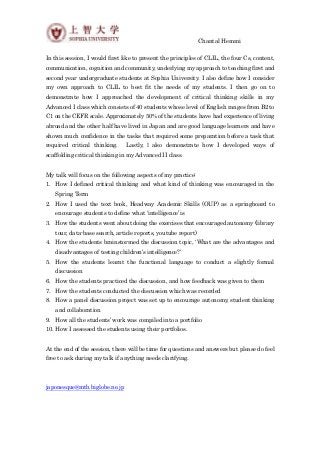
Senshuu handouts by Chantal Hemmi
- 1. Chantal Hemmi In this session, I would first like to present the principles of CLIL, the four Cs, content, communication, cognition and community, underlying my approach to teaching first and second year undergraduate students at Sophia University. I also define how I consider my own approach to CLIL to best fit the needs of my students. I then go on to demonstrate how I approached the development of critical thinking skills in my Advanced I class which consists of 40 students whose level of English ranges from B2 to C1 on the CEFR scale. Approximately 50% of the students have had experience of living abroad and the other half have lived in Japan and are good language learners and have shown much confidence in the tasks that required some preparation before a task that required critical thinking. Lastly, I also demonstrate how I developed ways of scaffolding critical thinking in my Advanced II class. My talk will focus on the following aspects of my practice: 1. How I defined critical thinking and what kind of thinking was encouraged in the Spring Term 2. How I used the text book, Headway Academic Skills (OUP) as a springboard to encourage students to define what ‘intelligence’ is 3. How the students went about doing the exercises that encouraged autonomy (library tour, data-base search, article reports, youtube report) 4. How the students brainstormed the discussion topic, ‘What are the advantages and disadvantages of testing children’s intelligence?’ 5. How the students learnt the functional language to conduct a slightly formal discussion 6. How the students practiced the discussion, and how feedback was given to them 7. How the students conducted the discussion which was recorded 8. How a panel discussion project was set up to encourage autonomy, student thinking and collaboration 9. How all the students’ work was compiled into a portfolio 10. How I assessed the students using their portfolios. At the end of the session, there will be time for questions and answers but please do feel free to ask during my talk if anything needs clarifying. japonesque@mtb.biglobe.ne.jp
